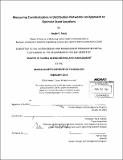| dc.contributor.advisor | Roy E. Welsch. | en_US |
| dc.contributor.author | Sapaj, Sergio C. (Sergio Constantino Sapaj Sabaj) | en_US |
| dc.contributor.other | Massachusetts Institute of Technology. Engineering Systems Division. | en_US |
| dc.date.accessioned | 2014-01-09T19:56:24Z | |
| dc.date.available | 2014-01-09T19:56:24Z | |
| dc.date.issued | 2013 | en_US |
| dc.identifier.uri | http://hdl.handle.net/1721.1/83799 | |
| dc.description | Thesis (S.M. in Engineering and Management)--Massachusetts Institute of Technology, Engineering Systems Division, 2013. | en_US |
| dc.description | Cataloged from PDF version of thesis. | en_US |
| dc.description | Includes bibliographical references (page 99). | en_US |
| dc.description.abstract | A methodology was proposed to measure sales cannibalization using historic data containing variations in store densities. Sales cannibalization was defined as a decrease in the sales of one or several existing stores as a result of nearby store openings. The proposed methodology, combining regressions with geographic and other forms of cluster analysis, allowed measurement of the cannibalization, while controlling for other relevant sales drivers such as consumers' and geographic areas' characteristics, seasonality and the nature of the demand of the product category (impulsive and non-impulsive purchases). The analysis found evidence of sales cannibalization in the store network studied and showed that its severity varies according to consumers' and geographic areas' characteristics and product category. This last finding was particularly relevant, as cannibalization was consistently more severe for non-impulsive products. Based on the cannibalization measurements, sales functions were created and then optimized to find the number of stores maximizing total sales. This number represents saturation, meaning a point beyond which any new store opening in the area just redistributes sales. The number of stores maximizing sales, however, may not be the goal, particularly when fixed costs associated with operating stores are important and when attempting to maintain attractive businesses for store owners, which is relevant in franchised settings. | en_US |
| dc.description.statementofresponsibility | by Sergio C. Sapaj. | en_US |
| dc.format.extent | 99 pages | en_US |
| dc.language.iso | eng | en_US |
| dc.publisher | Massachusetts Institute of Technology | en_US |
| dc.rights | M.I.T. theses are protected by
copyright. They may be viewed from this source for any purpose, but
reproduction or distribution in any format is prohibited without written
permission. See provided URL for inquiries about permission. | en_US |
| dc.rights.uri | http://dspace.mit.edu/handle/1721.1/7582 | en_US |
| dc.subject | Engineering Systems Division. | en_US |
| dc.title | Measuring cannibalization in distribution networks : an approach to optimize store locations | en_US |
| dc.type | Thesis | en_US |
| dc.description.degree | S.M.in Engineering and Management | en_US |
| dc.contributor.department | Massachusetts Institute of Technology. Engineering Systems Division | |
| dc.identifier.oclc | 865474672 | en_US |
